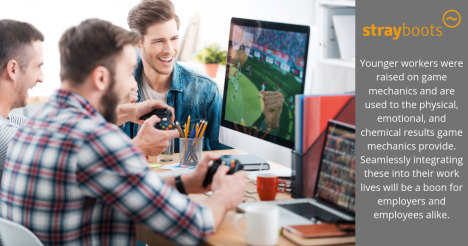How Gamification Can Help Companies Recruit, and Keep, Young Workers
More than half of American young adults play video games regularly, and many older adults also spend part of their day gaming. Just how long are Americans gaming these days? According to a major study, just around 6.4 hours a week. That’s a lot of time spent playing Fortnite.
Translating this – and the expectations set by these experiences – to the world of work can be difficult, some may say impossible. However, employers ignore the growing popularity of gaming at their peril. For better or for worse, for this generation as well as generations to come, gamification is the norm. In fact, more than 27 percent of gamers admit to gaming at work at least once a month already. By some reports, young people today are already watching esports tournaments and other gamers more than traditional sports, and the trends show no signs of abating.
How can companies harness this energy for the good of the workplace? How can workplace gamification be most effectively employed to attract and engage young talent?
The History of Gamification
For almost two decades, companies have been experimenting with gamification. Various tools and strategies related to gamification have been (or are actively being) employed by a wide range of companies to motivate and teach their workforces; everyone from Facebook to Volkswagen, DirecTV, and Nike. From the amount of research done on the subject, it’s easy to see why.
According to Steve Dale in an article in Business Information Review, “Gamification is much more than simply rewarding points and badges; it is about understanding and influencing the human behaviors that companies want to encourage among their users. Gamification is founded in the fundamentals of human psychology and behavioral science and rests on three primary factors: motivation, ability level and triggers.”
Many studies have revealed that dopamine is released during gamification exercises (we all know there’s a certain rush in clearing a level or gaining a reward for completing a task on our favorite mobile games). However, gamification has also been shown to positively impact a person’s ability to learn. “Gamification provides an experience that is inherently engaging and, most importantly, promotes learning,” Dale said. “The elements of games that make for effective gamification are those of storytelling, which provides a context, challenge, immediate feedback, sense of curiosity, problem-solving, a sense of accomplishment, autonomy, and mastery.”

The Next Generation of Gamification
The enterprise space is flooded with hundreds of gamification platforms. These platforms provide a range of tools used by everyone from operations to sales teams. They offer businesses nearly unlimited options to suit many corporate objectives. Examples of gamification platforms include Bunchball (cloud-based gamification products to help companies to improve customer acquisition and loyalty), and Gameffective (designed to aid companies in improving a myriad of different areas including sales, e-learning, and onboarding).
However, as gamification options continue to grow, HR executives should be mindful that tools don’t see employees glued to their seats and screens exclusively. ‘Sitting is the new smoking’ is a popular health dictum today, and yet another potential problem associated with an overreliance on online tools is that of isolation. Yes, digital interaction is still interaction, but people are getting lonelier and lonelier. Loneliness in the world is quickly being recognized as a global health problem.
Newer technologies and strategies that seek to converge the digital and physical worlds to overcome the issues of isolation and immobility are showing promise. In the consumer space, the summer of 2016’s Pokemon GO launched and promptly became the smash hit of the summer; overall augmented reality technology (AR) and virtual reality (VR) have the potential to change the nature of play and learning both at home and work, ensuring that people are moving in real space, not just moving avatars. And at Strayboots we continue to evolve our offerings and our platform to ensure that our offerings include digital tools as well as those promoting movement and social interaction between co-workers.
Winning the Esports Generation
Making sure the workplace is adapted for the Esports generation is important for the continuing success of a business. Younger workers were raised on game mechanics and are used to the physical, emotional, and chemical results game mechanics provide. Seamlessly integrating these into their work lives will be a boon for all those involved. While it may take some time to get used to watercooler talk turning from Monday Night Football to last night’s League of Legends Final, gaming is roaring into the workplace and it might as well be used to make your business even better.



